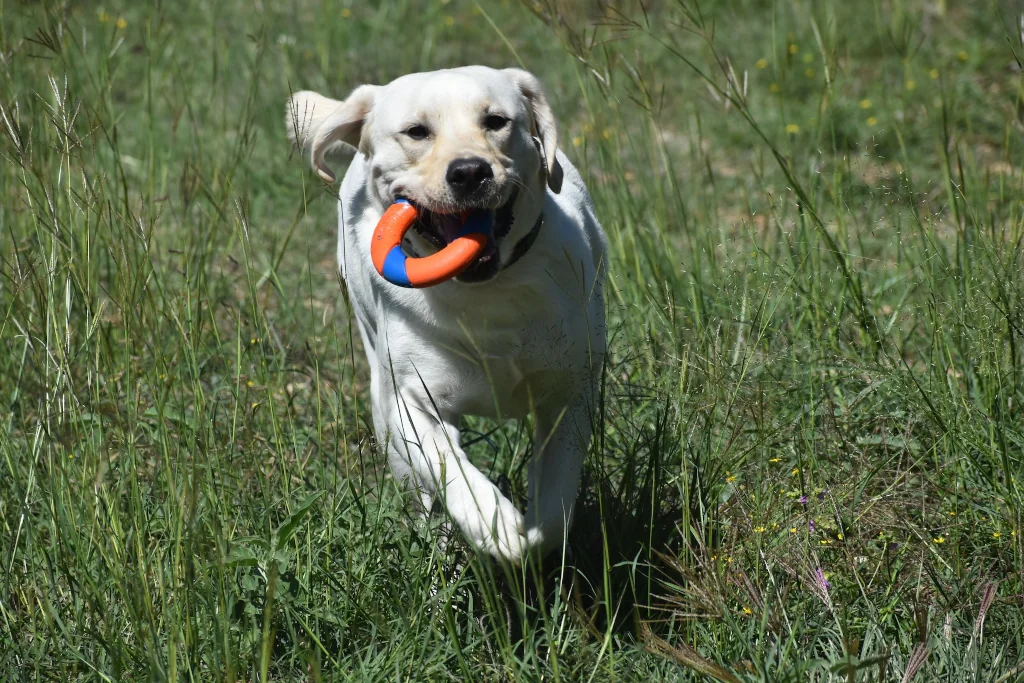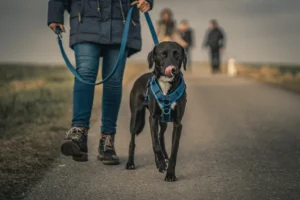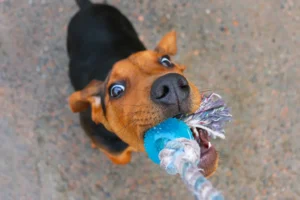Challenged by the endless tug-o-war with your dog during training? Fed up with treats disappearing faster than they motivate?
Hold onto your leash – toys might be your next best training tool. Remember those captivating squeaky toys and fuzzy stuffed animals? They are not just items of entertainment but can also serve as a secret weapon to amp up your dog training regimen.
Let’s dive into why toys can be the game-changer you’ve been missing in your dog training journey.

Why Do Dogs Need Toys for Training?
Dogs, just like us, need a variety of stimuli to keep their minds sharp and their behaviors in check.
Enter toys – a multitasker that satisfies their natural urge to play and chew while also adding a fun twist to training.
Training with toys promotes focus, as your furry friend learns to concentrate on the task at hand to earn their favorite squeaky reward. Plus, the anticipation of play keeps them excited about the training, making the whole process less of a chore and more of a cherished playtime.
Psychological Benefits of Toys for Dogs
Toys aren’t just playthings; they’re a passport to your dog’s mental wellbeing:
Chewing on a toy, for example, helps your dog relieve stress and feel more secure in their environment.
Interactive toys that challenge them to fetch, tug, or solve a puzzle work wonders in stimulating their cognitive skills.
And here’s a bonus – toys can foster positive behaviors, such as patience and focus, which are essential during training.
So, in essence, every time your dog frolics with a toy, they’re exercising their brain, releasing pent-up energy, and inching closer to becoming a well-trained, well-behaved pet.
Can Toys Replace Food as Training Rewards?
If you’re asking this, you’re already on the right track. Yes, toys can indeed replace food as training rewards, especially for dogs with high play drive.
Here’s the inside scoop from my years of dog training experience: a game of tug or a fetch session can be just as enticing as a tasty morsel. However, it’s essential to remember that all dogs are different, and some may respond better to food while others are more toy-motivated.
So, it’s always a good idea to have both in your training toolkit and use them based on your dog’s preference and the situation.
Read more: How to Choose the Right Training Toy for Your Dog
What Do Dogs Think When They Play With Toys?
As much as we’d love to hear our dogs’ thoughts, we can only make educated guesses based on their behavior.
For dogs, toys are not just inanimate objects; they represent fun, engagement, and reward.
When they play with a toy, they’re essentially ‘hunting,’ tapping into their natural instinct to chase and capture. This play-hunt provides them with mental stimulation and physical exercise, thus fulfilling their instinctual needs.
Moreover, when used during training, toys can symbolize achievement and reward, reinforcing the learned behavior.
How to Use Toys for Rewarding Calm Behavior
Incorporating toys to reward calm behavior is an effective and fun method in dog training.
Start by choosing a toy your dog loves but isn’t overly excited about. This balance is key to maintain calmness.
First, ask your dog to sit or lay down, then gently present the toy. If they stay calm, allow them to have the toy. If they get over-excited, remove the toy and try again later.
Consistency is essential here. Remember, the goal is not to suppress their excitement completely but to teach them to control it. This way, toys become not just a source of fun, but also a tool for teaching self-control and patience.
Read more: Teach your dog to sit or lay down
Training Tips for Dogs Who Aren’t Toy-Motivated
Not all dogs are wired the same, and it’s okay if your furry friend doesn’t get starry-eyed at the sight of a toy. For dogs that aren’t toy-motivated, you can still make the training sessions fun and rewarding using different methods.
For instance, verbal praise or gentle petting can work wonders for dogs that value social interactions over toys.
Food rewards can be very effective. But here’s a secret tip that many might overlook: You can also try to build up their interest in toys gradually. Start by incorporating the toy into play sessions or meal times.
I remember Charlie, my golden retriever, showed no interest in toys until one day, I stuffed a kong toy with his favorite peanut butter treat. The next thing I knew, he wouldn’t leave it alone! The best result you’ll get is by picking the right toy for your dog.
To learn more, follow our blog post on choosing the perfect training toy for your dog. We’ll show you what to keep in mind, how many toys to get, and how to choose the durable ones that last forever.
FAQs
Should I let my dog have toys all the time?
While it’s great for dogs to have access to toys, moderation is key. Leaving toys out all the time may lead to boredom as the novelty wears off. Moreover, constant access might increase the risk of the toy becoming a chewing object rather than a tool for engagement and reward.
Can you train a dog with toys?
Absolutely! Toys can be an excellent tool for training dogs. They can serve as motivational rewards and stimulate a dog’s instinctual drive, thus reinforcing positive behavior during training sessions.
Do certain dog breeds respond better to toy training?
Certain breeds with a high prey drive, like terriers and retrievers, might respond exceptionally well to toy training due to their innate urge to chase and capture. However, individual dog personalities also play a significant role.
Are there certain types of toys that should be avoided in training?
Safety is paramount. Avoid toys that can easily break into small pieces or have sharp edges as they might pose a choking hazard or injure your dog. Additionally, overly noisy toys may distract more than they motivate during a training session.
Alex, a passionate animal lover, has experience in training and understanding animal behavior. As a proud pet parent to two dogs and three cats, he founded AnimalReport.net to share insights from animal experts and expand his knowledge of the animal kingdom.









